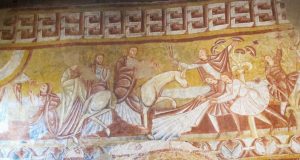
This is the Third Eye Drops podcast, “Resurrecting the Mystery School,” with The Psychedelic Gospels coauthor Jerry B. Brown, Ph.D. (This Mind Meld 65 interview begins at 00:09:42 and runs for about an hour.)
Third Eye Drops Podcast – Mind Meld 65
Third Eye Drops podcast host Michael Phillip invites all “wonder seekers” to listen in to this “psychedelic Indian Jones” story, which lays the foundation for a “techno-delic future” by probing the past to reveal the secret history of psychedelics in Christianity and other world religions.
Phillip writes: “As I mentioned in the write-up for this episode, I wish this mind meld were more than a podcast. In the spirit of that desire, here are some massively thought-provoking images that Psychedelic Gospels author, Dr. Jerry Brown shared with me during our chat. Whether you’re seeing these remarkable pieces as you listen, after the fact or you’re just perusing, I hope you enjoy their their mysterious majesty!” Third Eye Drops – Mind Meld 65: click here for complete visual companion to podcast.
The following are Selections from the transcript of this Third Eye Drops Podcast, along with original photos of psychedelics in Christian art taken by Julie M. Brown, coauthor, The Psychedelic Gospels, and with commentary by Michael Phillip. (The transcript has been lightly edited by Jerry Brown for clarity.)
The Green Man and the Mushroom – Rosslyn Chapel, Scotland

“This is one of over one hundred “green man” heads united by a sinuous vine that weaves through Rosslyn Chapel. The head is surrounded by laurels and there are vines growing out of his mouth. It was so impressive, I bought a plaster replica. About two weeks later, my wife Julie and I were sitting in an Italian restaurant. I take this green man head out and put it on the table, you know, just absentmindedly. I turn it around and there I discover, sculpted upside down in the forehead over the pineal gland, an Amanita mushroom.”
Psychedelics in French Frescos: Plaincourault and St. Martin de Vicq

“Our first stop was in the tiny chapel of Plaincourault in the center of France, about 60 feet deep and 20 feet wide. On the back wall is this fresco of Adam and Eve painted about a thousand years ago. It depicts the figures flanking an Amanita mushroom complete with red and white dots meticulously and systematically drawn on the cap with other mushrooms clustered around the base. Adam and Eve are not covering themselves with fig leafs, but with mushroom caps. This led us to a complete reinterpretation of the Eden story.”

“About two hours east of Plaincourault is the parish church of St. Martin de Vicq, again about a thousand years old. We walked into the choir of the church a saw a Christology — a visual story of the life of Christ. In this particular fresco, you have Jesus entering Jerusalem. What we see here are the joyful youth greeting Jesus as he enters Jerusalem. They’re holding onto the stems of large, tan, smooth psilocybin mushrooms. Again, they’re large because the artist wants to call our attention to them.”
“We turn to the right, facing the wall perpendicular to this one and we see another fresco depicting the towers of Jerusalem and up on top of the tower are youths with long knives cutting down large mushroom caps from the towers.”
The Last Supper, St. Martin de Vicq

“If that were not enough, this scene is right over a long wide painting of The Last Supper. On at the table are the same long knives used to cut down the psychoactive mushrooms from the tower of Jerusalem and mushroom caps cut up.”
After finding so much seemingly psychedelic iconography in central France, Dr. Brown and his wife wondered – was this evidence of some sort of isolated psychedelic cult within the church, or were these references more widespread? To find out, they traveled to more prominent, high-profile holy sites. Places like St. Michael’s Church in Germany, Canterbury Church in England, and Chartres Cathedral in France.
At all of them, Dr. Brown says, they found evidence of entheogens (sacred plants that generate the divine within).
Chartres Cathedral, France

“We found evidence of psychedelics in nearly 10 percent of all the stained-glass windows in Chartres Cathedral. Here’s one example. This is the conversion of Placidas the hunter. In his moment of illumination when he becomes Saint Eustace, Placidas is surrounded by what we believe are psilocybin mushrooms. And there, coming down from the heavens through concentric circles, we see the hand of the holy spirit pouring illumination into Saint Eustace’s head in the context of magic mushrooms.”
Canterbury Cathedral, Canterbury, England

“At the Canterbury Scriptorium, a place where bibles were created from the time of Thomas Becket, Archbishop of Canterbury. There, the illuminated bible called “The Great Canterbury Psalter” was created. This was a large leather-bound, jewel-studded book with gold inlays. It was made for, maybe the king of France or the king of England. It’s richly illustrated. This image comes from Genesis, from the very first page and it is the front piece of our book. This is supposed to depict “God creates plants,” but wait a minute, here is “God creating psychoactive mushrooms.’”
Jesus Heals the Leper

Here’s another image in the Canterbury Psalter discussed by Dr. Brown. It depicts Jesus atop a mound of mushrooms and mushroom-like objects healing a leper. Take note of the leper’s scroll. On it is a request to be healed. Interestingly the scroll reaches not up toward Jesus, but directly down toward a mushroom.
In addition to the images mentioned by Dr. Brown, there are a number of other very clear references to mushrooms in the Canterbury Psalter. Give it a Google.
Saint Michael’s Church, Germany
“We know and understand that groups of people sponsored these churches and this art… However, when we comes to St. Michael’s Church in in northern Germany, we actually do know the artist. It’s Bishop Bernward, a prominent member of the medieval clergy. He was tutor to Otto III, who was actually the Holy Roman Emperor. He was a brilliant man. He was a metallurgist, mathematician and builder.

He had, for the glory of God, two massive bronze pieces cast for Saint Michael’s Church. One was a set of large bronze doors highlighting the story of Genesis and the life of Jesus. The other was a twelve-foot-high Christ column. It shows 23 scenes from the life of Jesus from his baptism to his entry into Jerusalem. In this particular scene is the transformation of Jesus. It’s very important because it’s one of the two miracles that happen directly to Jesus. In this one, God appears before Jesus and his disciples and says “This is my son, hear him well,” as Jesus and his disciples stand beneath psilocybin mushrooms. The variety is so clearly drawn that ethnobotanists are able to tell us the species.”
Jesse Tree, Ceiling Painting, St. Michael’s Church

Here, in another prominently-placed image in St. Michael’s cathedral, this time from a ceiling painting, created by Bishop Bernward’s successors more than two centuries after his death. We again see Adam and Eve, time up against a red and white speckled circular backdrop. Could this be another Amanita reference? Yes, indeed, it is.
Third Eye Drops Host Michael Phillip

Third Eye Drops – Dig Deeper – Gratitude for listening and reading along, my fellow wonder-seekers! To further explore the link between psychedelics and religion, traverse this portal to the home of the Psychedelic Gospels. You can also commune Dr. Brown and his wife and co-author Julie Brown directly via the Psychedelic Gospels Facebook page.
Third Eye Drops. click here for complete visual companion to podcast.
To learn more about The Psychedelic Gospels: The Secret History of Hallucinogens in Christianity, visit the Psychedelic Gospels website.







